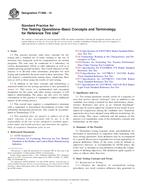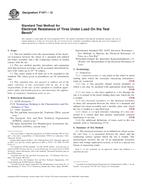Potřebujeme váš souhlas k využití jednotlivých dat, aby se vám mimo jiné mohly ukazovat informace týkající se vašich zájmů. Souhlas udělíte kliknutím na tlačítko „OK“.
ASTM D7760-12
Standard Test Method for Measurement of Hydraulic Conductivity of Tire Derived Aggregates Using a Rigid Wall Permeameter
Automaticky přeložený název:
Standardní zkušební metoda pro měření hydraulické vodivosti pneumatiky odvozené Agregáty pomocí pevnou stěnu permeametr
NORMA vydána dne 1.6.2012
Informace o normě:
Označení normy: ASTM D7760-12
Poznámka: NEPLATNÁ
Datum vydání normy: 1.6.2012
Kód zboží: NS-39080
Počet stran: 6
Přibližná hmotnost: 18 g (0.04 liber)
Země: Americká technická norma
Kategorie: Technické normy ASTM
Kategorie - podobné normy:
Anotace textu normy ASTM D7760-12 :
Keywords:
constant head, hydraulic conductivity, scrap tire, shredded tires, tire chips, tire derived aggregate, ICS Number Code 83.160.01 (Tyres in general)
Doplňující informace
| Significance and Use | ||||||||||||
|
4.1 This test method is used to measure one-dimensional vertical flow of water through initially saturated TDAs under an applied hydraulic gradient. Hydraulic conductivity is required in various civil engineering applications of TDAs. 4.2 TDAs are to be tested at a unit weight and under an overburden pressure representative of field conditions. Data from the literature indicate a reduction in hydraulic conductivity with increasing vertical pressure 4.3 Use of a dual-ring permeameter is included in this test method in addition to a single-ring permeameter. The dual-ring permeameter allows for minimizing potential adverse effects of sidewall leakage on measured hydraulic conductivity of the test specimens. The use of a bottom plate with an inner ring with a diameter smaller than the diameter of the permeameter and two outflow ports (one from the inner ring, one from the annular space between the inner ring and the permeameter) allows for separating the flow from the central part of the test specimen from the flow near the sidewall of the permeameter. 4.4 Darcy's law is assumed to be valid, flow is assumed to be laminar (Reynolds number less than approximately 2000–3000), and the hydraulic conductivity is assumed to be essentially independent of hydraulic gradient. The validity of Darcy's law may be evaluated by measuring the hydraulic conductivity of a specimen at three hydraulic gradients. The discharge velocity (v = k × i) is plotted against the applied hydraulic gradient. If the resulting relationship is linear and the measured hydraulic conductivity values are similar (i.e., within 25 %), then Darcy’s law may be taken as valid. 1.1 This test method covers
laboratory measurement of the hydraulic conductivity (also referred
to as coefficient of
permeability) of water-saturated tired derived aggregates
(TDA) obtained from scrap tires using a rigid-wall permeameter. The
tire materials covered in this method include tire chips, tire
shreds, and tire derived aggregate (TDA) as described in Practice
D6270 with particle sizes ranging from approximately 12 to 305 mm.
Whole scrap tires are not included in this standard. A clear trend
between hydraulic conductivity and shred size has not been
established at a given vertical pressure for shreds ≥50 mm (1).2
1.2 A single- or dual-ring permeameter may be used in the tests. A dual-ring permeameter may be preferred over a single-ring permeameter to take into account and prevent short-circuiting of permeant along the sidewalls of the permeameter. The effects of sidewall flow is more significant at high stresses and when the cell diameter is less than 6 times the particle size 1.3 The test method is used under constant head conditions. 1.4 Water is used as the permeant with the test method. 1.5 Test Method D2434 also can be used for determination of hydraulic conductivity of TDAs with sizes smaller than 19 mm under constant head conditions in a rigid-wall permeameter. Method D2434 includes the use of a permeameter with a single ring. 1.6 The standard units for the hydraulic conductivity values are the SI units, unless other units are specified. Hydraulic conductivity has traditionally been expressed in cm/s in the U.S., even though the official SI unit for hydraulic conductivity is m/s. 1.7 This standard does not purport to address all of the safety concerns, if any, associated with its use. It is the responsibility of the user of this standard to establish appropriate safety and health practices and determine the applicability of regulatory limitations prior to use. |
||||||||||||
| 2. Referenced Documents | ||||||||||||
|
Podobné normy:
Historická
1.2.2013
Historická
15.5.2014
Historická
1.1.2011
Historická
1.12.2010
Historická
1.6.2014
Historická
1.5.2012



 ASTM D6700-01(2013)..
ASTM D6700-01(2013).. ASTM D885/D885M-10a(..
ASTM D885/D885M-10a(.. ASTM E1859/E1859M-11..
ASTM E1859/E1859M-11.. ASTM F1112-06a(2010)..
ASTM F1112-06a(2010).. ASTM F1806-14
ASTM F1806-14 ASTM F1971-12
ASTM F1971-12
 Cookies
Cookies
